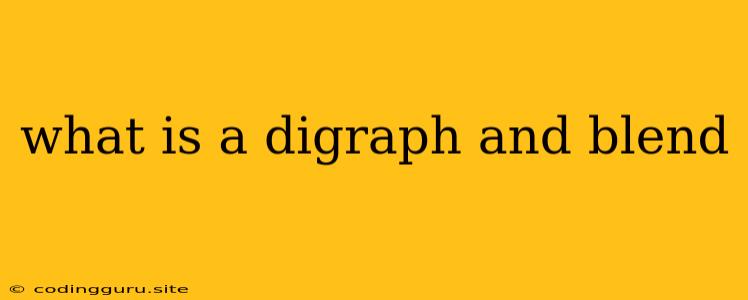What is a Digraph and Blend?
When learning about the building blocks of language, you might encounter the terms "digraph" and "blend." While they sound similar, they represent different aspects of letter combinations in written English. So, what exactly are digraphs and blends, and how do they differ?
Digraphs are a pair of letters that represent a single sound. They are often tricky for beginning readers because the letters don't sound like their individual sounds. Think of the letters "sh" in "ship" or "th" in "thin." These combinations produce a single sound that's distinct from the sounds of the individual letters.
Blends are also letter combinations, but unlike digraphs, they are groups of consonants that are blended together to make a new sound. These blends often start with a consonant sound followed by another consonant sound that is heard distinctly. Examples include "bl" in "blue" or "fr" in "frog."
Digraphs Explained
Digraphs are a fascinating part of the English language. They help us represent sounds that are not easily represented by single letters. Here's a breakdown of digraphs:
- Types of Digraphs: There are various types of digraphs, including:
- Consonant Digraphs: These digraphs represent a single consonant sound. Examples include:
- "sh" as in "ship"
- "ch" as in "chair"
- "th" as in "thin"
- "wh" as in "where"
- "ph" as in "phone"
- Vowel Digraphs: These digraphs represent a single vowel sound. Examples include:
- "ai" as in "rain"
- "ea" as in "bread"
- "ie" as in "pie"
- "oo" as in "moon"
- Consonant Digraphs: These digraphs represent a single consonant sound. Examples include:
- Importance of Digraphs: Digraphs play a crucial role in reading and spelling. They allow us to represent a wide range of sounds in the English language using a limited number of letters. Understanding digraphs is essential for developing strong reading and spelling skills.
Blends Explained
Blends are another type of letter combination that plays a crucial role in the English language.
- Characteristics of Blends:
- Blends consist of two or more consonants that are blended together to make a new sound.
- The consonant sounds in a blend are usually pronounced distinctly, unlike digraphs where the sounds are combined into a single sound.
- Blends typically occur at the beginning of words.
- Types of Blends: There are various types of blends, including:
- Two-letter blends: "bl," "br," "cl," "cr," "dr," "fl," "fr," "gl," "gr," "pl," "pr," "sl," "sm," "sn," "sp," "st," "tr," "tw"
- Three-letter blends: "scr," "shr," "spl," "spr," "str"
Digraphs vs. Blends: Key Differences
To recap, here are the key differences between digraphs and blends:
| Feature | Digraph | Blend |
|---|---|---|
| Letters | Two letters representing a single sound | Two or more consonants blended together |
| Sound | Single, distinct sound | Combination of sounds pronounced separately |
| Example | "sh" in "ship" | "bl" in "blue" |
Tips for Teaching Digraphs and Blends
Teaching children about digraphs and blends can be a fun and interactive experience. Here are some tips:
- Use Visual Aids: Colorful charts and flashcards with examples of digraphs and blends can be helpful for visual learners.
- Sing Songs: Many popular children's songs and rhymes incorporate digraphs and blends.
- Play Games: Word games like "I Spy" or "Bingo" using words with digraphs and blends can engage children and encourage active learning.
- Read Aloud: Reading aloud to children exposes them to various words with digraphs and blends.
- Practice Writing: Encourage children to write words with digraphs and blends, using their hands-on experience to reinforce learning.
Conclusion
Digraphs and blends are important elements of the English language. By understanding these letter combinations, readers can decipher words more effectively, and writers can express themselves with greater accuracy. Learning about digraphs and blends provides a strong foundation for reading and spelling success, paving the way for a deeper understanding of the English language.
